Analysis of Volatile Profile of Polish Gouda-Type Cheese and Its Analogue
Abstract
1. Introduction
2. Materials and Methods
2.1. Production Procedure of Gouda-Type Cheese and Its Analogue
2.2. Samples Used for Measurements
2.3. GC-MS Measurement of Volatiles
2.3.1. Sample Preparation
2.3.2. Volatile Collection
2.3.3. GC-MS Measurements
2.3.4. GC-MS Raw Data Analysis
2.4. Electronic Nose
2.4.1. Electronic Nose Device
2.4.2. Sample Preparation
2.4.3. Measurements by Electronic Nose
2.5. Data Analysis
2.5.1. Visualization of Experimental Data
2.5.2. Electronic Nose Data Analysis
2.5.3. Software Packages for Data Analysis
3. Results of Measurements
3.1. Gas Chromatography–Mass Spectrometry
3.2. Electronic Nose
3.2.1. Sensor Response
3.2.2. Principal Components Analysis
3.2.3. Support Vector Machine (SVM) Classification Model
4. Discussion
4.1. Detected Chemical Components
- 5-methyl-2-hexanone is a ketone, a colorless liquid with a pleasantly fruity odor. The chemical compound is less dense than water, and its vapors are heavier than air. According to our best knowledge, this substance has not been previously detected in Gouda cheese or its analogues; however, GC/MS analyses have confirmed its presence both in processed cheese, as reported by Sunesen et al. [44], and in liquid culture medium isolated from surface-ripened French cheese, as described by Deetae et al. [45].
- 4-hydroxybutan-2-butanone, beta-hydroxy ketone, is a colorless liquid with a sweet, fruity odor. According to our best knowledge, this compound has not been previously detected in studies on volatile compounds in cheeses; however, it has been identified as a natural constituent in Glycyrrhiza glabra L. [46], a medicinal plant with well-documented pharmacological activity, and in the fungus Dictyophora rubrovolata Zang [47].
- 2-Heptanone, N-amyl methyl ketone, is a clear colorless liquid, less dense than water, and only slightly soluble in water, with vapors heavier than air. It is used for synthetic flavoring and in perfumes and has a banana-like, fruity odor. This chemical component was found by Sloot et al. [17], van Leuven et al. [18], Shiota et al. [22], Jo et al. [19], and Sýkora et al. [48] in the context of aroma characterization of Gouda-type cheeses.
- Hexadecane is a component of essential oils isolated from long pepper, having the role of a plant metabolite. The reported odor is gasoline-like to odorless. This compound was identified in the composition of semi-hard traditional cheese during studies conducted by Povolo et al. [49], as well as in volatile flavor compounds found in enzyme-modified cheese mixed with Soy–Cow’s milk, as described by Ali et al. [50].
- Octadecane has the role of a bacterial and plant metabolite and is reported to be odorless. While it has not yet been detected as a volatile compound in cheese, it has been frequently reported in the analysis of volatiles from plants such as Lagenaria breviflora R. [51] and Symplocos crataegoides Buch.-Ham. [52].
- 3-Methyl-2-butanone is a colorless liquid. The reported odor is sharp and pleasant, resembling other ketones with an acetone-like character. While this compound has not been previously detected in Gouda cheese, it has been identified in other types of cheese, such as Idiazabal cheese manufactured from ewe’s milk, as reported by Barron et al. [53], and in volatile compounds of Emmental cheese juice, as described by Thierry et al. [54].
- 3-Hydroxy-2-butanone, acetonin, is known as a product of fermentation. The reported odor is bland and yogurt-like. It is one of the compounds that gives butter its characteristic flavor. This chemical component was found by van Leuven et al. [18] and Chen et al. [21] in the aroma characterization of Gouda-type cheeses. Additionally, 3-hydroxy-2-butanone was identified among the volatile compounds of Hispánico cheese through GC/MS analysis [55] and in cream cheese [56].
- 2-Pentanone, methyl propyl ketone, is a clear colorless liquid with the odor of fingernail polish resembling acetone. It occurs naturally in Nicotiana tabacum (Tobacco) and blue cheese as a metabolic product of Penicillium mold growth. This chemical component was found by van Leuven et al. [18], Shiota et al. [22], and Chen et al. [21] in aroma characterization of Gouda-type cheeses.
- 3-Hydroxy-1-butanol, isoamyl alcohol, is a colorless liquid with a mild, choking alcohol odor. It is an ingredient in the production of banana oil. It is found in nature and also produced in industry as a flavoring.
4.2. Other Studies of Gouda Cheese Odor Composition
4.3. Electronic Nose vs. GC-MS Measurements
4.4. Differences of Methods of Production
5. Summary and Conclusions
Author Contributions
Funding
Institutional Review Board Statement
Informed Consent Statement
Data Availability Statement
Conflicts of Interest
References
- Zaręba, D.; Ziarno, M. Analogi: Wyroby podobne i analogi – podróbki czy nowy trend w produkcji żywności? Forum Mlecz. Bizn. 2015, 2, 21. [Google Scholar]
- Johnson, M.E. A 100-Year Review: Cheese production and quality. J. Dairy Sci. 2017, 100, 9952–9965. [Google Scholar] [CrossRef] [PubMed]
- Forum Mleczarskie, Podręcznik Serowy, Europejskie Specjalności, Gouda. Available online: https://www.forummleczarskie.pl/podrecznik-serowy/europa/16,gouda (accessed on 20 December 2024).
- Ferawati, F.; Hefni, M.; Östbring, K.; Witthöft, C. The Application of Pulse Flours in the Development of Plant-Based Cheese Analogues: Proximate Composition, Color, and Texture Properties. Foods 2021, 10, 2208. [Google Scholar] [CrossRef] [PubMed]
- Rawa, Ł. Rynek Serów Twardych w Polsce Zmienia Się Bardzo Powoli. 2017. Available online: https://www.wiadomoscihandlowe.pl/wywiady-i-opinie/rynek-serow-twardych-w-polsce-zmienia-sie-bardzo-powoli-2424728 (accessed on 20 December 2024).
- Ceny sera Gouda Wzrosły do Najwyższego Poziomu w 2024 r. Available online: https://www.portalspozywczy.pl/mleko/wiadomosci/ceny-sera-gouda-wzrosly-do-najwyzszego-poziomu-w-2024-r,272920.html (accessed on 18 December 2024).
- Czuba, A.; Starkowski, M.T. Polska Jest w Tym potęGą! Available online: https://www.fakt.pl/pieniadze/za-miastem/jak-produkowane-sa-polskie-sery-jestesmy-w-tym-potega/k6c5n39 (accessed on 4 December 2020).
- Giha, V.; Ordoñez, M.J.; Villami, R.A. How does milk fat replacement influence cheese analogue microstructure, rheology, and texture profile? J. Food Sci. 2021, 86, 2802–2815. [Google Scholar] [CrossRef]
- Fox, P.F.; Guinee, T.P.; Cogan, T.M.; McSweeney, P.L.H. Fundamentals of Cheese Science, 2nd ed.; Springer: New York, NY, USA, 2017. [Google Scholar] [CrossRef]
- Bachmann, H.P. Cheese analogues: A review. Int. Dairy J. 2001, 11, 505–515. [Google Scholar] [CrossRef]
- Vítová, E.; Loupancová, B.; Sklenářová, K.; Divišová, R.; Buňka, F. Identification of volatile aroma compounds in processed cheese analogues based on different types of fat. Chemical Papers 2012, 66, 907–913. [Google Scholar] [CrossRef]
- Kilcawley, K.N.; Wilkinson, M.G.; Fox, P.F. Enzyme-modified cheese. Int. Dairy J. 1998, 8, 1–10. [Google Scholar] [CrossRef]
- Panescu, P.; Carter, M.; Cohen, M.; Ignaszewski, E.; Murray, S.; O’Donnell, M.; Pierce, B.; Voss, S. State of the Industry Report: Plant-Based Meat, Seafood, Eggs, and Dairy; GFI: Washington, DC, USA, 2022. [Google Scholar]
- Battle, M.; Pierce, B.; Carter, M.; Clarke, J.C.; Fathman, L.; Gertner, D.; Ignaszewski, E.; Kroger, N.; Leet-Otley, T.; Panescu, P. 2023 State of the Industry Report: Plant-Based Meat, Seafood, Eggs, and Dairy; The Good Food Institute: Arlington, VA, USA, 2023. [Google Scholar]
- Persaud, K.; Dodd, G. Analysis of discrimination mechanisms in the mammalian olfactory system using a model nose. Nature 1982, 299, 352–355. [Google Scholar] [CrossRef]
- Cheng, L.; Meng, Q.H.; Lilienthal, A.J.; Qi, P.F. Development of compact electronic noses: A review. Meas. Sci. Technol. 2021, 32, 062002. [Google Scholar] [CrossRef]
- Sloot, D.; Harkes, P.D. Volatile trace components in Gouda cheese. J. Agric. Food Chem. 1975, 23, 356–357. [Google Scholar] [CrossRef]
- Van Leuven, I.; Van Caelenberg, T.; Dirinck, P. Aroma characterisation of Gouda-type cheeses. Int. Dairy J. 2008, 18, 790–800. [Google Scholar] [CrossRef]
- Jo, Y.; Benoist, D.; Ameerally, A.; Drake, M. Sensory and chemical properties of Gouda cheese. J. Dairy Sci. 2018, 101, 1967–1989. [Google Scholar] [CrossRef] [PubMed]
- Lee, H.W.; Kim, I.S.; Kil, B.J.; Seo, E.; Park, H.; Ham, J.S.; Choi, Y.J.; Huh, C.S. Investigation of Flavor-Forming Starter Lactococcus lactis subsp. lactis LDTM6802 and Lactococcus lactis subsp. cremoris LDTM6803 in Miniature Gouda-Type Cheeses. J. Microbiol. Biotechnol. 2020, 30, 1404–1411. [Google Scholar] [CrossRef] [PubMed]
- Chen, C.; Tian, T.; Yu, H.; Yuan, H.; Wang, B.; Xu, Z.; Tian, H. Characterisation of the key volatile compounds of commercial Gouda cheeses and their contribution to aromas according to Chinese consumers’ preferences. Food Chem. X 2022, 15, 100416. [Google Scholar] [CrossRef]
- Shiota, M.; Iwasawa, A.; Suzuki-Iwashima, A.; Iida, F. Effects of Flavor and Texture on the Sensory Perception of Gouda-Type Cheese Varieties during Ripening Using Multivariate Analysis. J. Food Sci. 2015, 80, C2740–C2750. [Google Scholar] [CrossRef]
- Duensing, P.W.; Hinrichs, J.; Schieberle, P. Formation of Key Aroma Compounds During 30 Weeks of Ripening in Gouda-Type Cheese Produced from Pasteurized and Raw Milk. J. Agric. Food Chem. 2024, 72, 11072–11079. [Google Scholar] [CrossRef]
- Yakubu, H.G.; Kovacs, Z.; Toth, T.; Bazar, G. Trends in artificial aroma sensing by means of electronic nose technologies to advance dairy production—A review. Crit. Rev. Food Sci. Nutr. 2021, 63, 234–248. [Google Scholar] [CrossRef]
- O’Riordan, P.J.; Delahunty, C.M. Characterisation of commercial Cheddar cheese flavour. 1: Traditional and electronic nose approach to quality assessment and market classification. Int. Dairy J. 2003, 13, 355–370. [Google Scholar] [CrossRef]
- O’Riordan, P.J.; Delahunty, C.M. Characterisation of commercial Cheddar cheese flavour. 2: Study of Cheddar cheese discrimination by composition, volatile compounds and descriptive flavour assessment. Int. Dairy J. 2003, 13, 371–389. [Google Scholar] [CrossRef]
- Trihaas, J.; Vognsen, L.; Nielsen, P. Electronic nose: New tool in modelling the ripening of Danish blue cheese. Int. Dairy J. 2005, 15, 679–691. [Google Scholar] [CrossRef]
- Trihaas, J.; van den Tempel, T.; Nielsen, P.V. Electronic Nose Technology in Quality Assessment: Predicting Volatile Composition of Danish Blue Cheese During Ripening. J. Food Sci. 2005, 70, e392–e400. [Google Scholar] [CrossRef]
- Benedetti, S.; Sinelli, N.; Buratti, S.; Riva, M. Shelf Life of Crescenza Cheese as Measured by Electronic Nose. J. Dairy Sci. 2005, 88, 3044–3051. [Google Scholar] [CrossRef]
- Cevoli, C.; Cerretani, L.; Gori, A.; Caboni, M.; Toschi, T.G.; Fabbri, A. Classification of Pecorino cheeses using electronic nose combined with artificial neural network and comparison with GC–MS analysis of volatile compounds. Food Chem. 2011, 129, 1315–1319. [Google Scholar] [CrossRef] [PubMed]
- Sberveglieri, V.; Bhandari, M.; Núñez Carmona, E.; Betto, G.; Sberveglieri, G. A Novel MOS Nanowire Gas Sensor Device (S3) and GC-MS-Based Approach for the Characterization of Grated Parmigiano Reggiano Cheese. Biosensors 2016, 6, 60. [Google Scholar] [CrossRef]
- Abbatangelo, M.; Núñez-Carmona, E.; Sberveglieri, V.; Zappa, D.; Comini, E.; Sberveglieri, G. Application of a Novel S3 Nanowire Gas Sensor Device in Parallel with GC-MS for the Identification of Rind Percentage of Grated Parmigiano Reggiano. Sensors 2018, 18, 1617. [Google Scholar] [CrossRef]
- Štefániková, J.; Nagyová, V.; Hynšt, M.; Vietoris, V.; Martišová, P.; Nagyová, L. Application of electronic nose for determination of Slovak cheese authentication based on aroma profile. Potravin. Slovak J. Food Sci. 2019, 13, 262–267. [Google Scholar] [CrossRef][Green Version]
- Lee-Rangel, H.A.; Mendoza-Martinez, G.D.; Diaz de León-Martínez, L.; Relling, A.E.; Vazquez-Valladolid, A.; Palacios-Martínez, M.; Hernández-García, P.A.; Chay-Canul, A.J.; Flores-Ramirez, R.; Roque-Jiménez, J.A. Application of an Electronic Nose and HS-SPME/GC-MS to Determine Volatile Organic Compounds in Fresh Mexican Cheese. Foods 2022, 11, 1887. [Google Scholar] [CrossRef]
- Adams, R.P. Identification of Essential Oil Components by Gas Chromatography/Mass Spectrometry, 4th ed.; Texensis Publishing: Gruver, TX, USA, 2017. [Google Scholar]
- Tkachev, A.V. Chirospecific Analysis of Plant Volatiles. Russ. Chem. Rev. 2008, 76, 951. [Google Scholar] [CrossRef]
- Borowik, P.; Adamowicz, L.; Tarakowski, R.; Wacławik, P.; Oszako, T.; Ślusarski, S.; Tkaczyk, M. Application of a Low-Cost Electronic Nose for Differentiation between Pathogenic Oomycetes Pythium intermedium and Phytophthora plurivora. Sensors 2021, 21, 1326. [Google Scholar] [CrossRef]
- Borowik, P.; Grzywacz, T.; Tarakowski, R.; Tkaczyk, M.; Ślusarski, S.; Dyshko, V.; Oszako, T. Development of a Low-Cost Electronic Nose with an Open Sensor Chamber: Application to Detection of Ciboria batschiana. Sensors 2023, 23, 627. [Google Scholar] [CrossRef]
- Figaro Engineering Inc. MOS Type Sensors Operating Principle. Available online: https://www.figarosensor.com/technicalinfo/principle/mos-type.html (accessed on 30 April 2024).
- Cervera Gómez, J.; Pelegri-Sebastia, J.; Lajara, R. Circuit Topologies for MOS-Type Gas Sensor. Electronics 2020, 9, 525. [Google Scholar] [CrossRef]
- Pedregosa, F.; Varoquaux, G.; Gramfort, A.; Michel, V.; Thirion, B.; Grisel, O.; Blondel, M.; Prettenhofer, P.; Weiss, R.; Dubourg, V.; et al. Scikit-learn: Machine Learning in Python. J. Mach. Learn. Res. 2011, 12, 2825–2830. [Google Scholar]
- Virtanen, P.; Gommers, R.; Oliphant, T.E.; Haberland, M.; Reddy, T.; Cournapeau, D.; Burovski, E.; Peterson, P.; Weckesser, W.; Bright, J.; et al. SciPy 1.0: Fundamental Algorithms for Scientific Computing in Python. Nat. Methods 2020, 17, 261–272. [Google Scholar] [CrossRef] [PubMed]
- National Library of Medicine, National Center for Biotechnology Information, PubChem. Available online: https://pubchem.ncbi.nlm.nih.gov/ (accessed on 24 November 2024).
- Sunesen, L.O.; Lund, P.; Sørensen, J.; Hølmer, G. Development of Volatile Compounds in Processed Cheese during Storage. LWT—Food Sci. Technol. 2002, 35, 128–134. [Google Scholar] [CrossRef]
- Deetae, P.; Bonnarme, P.; Spinnler, H.E.; Helinck, S. Production of volatile aroma compounds by bacterial strains isolated from different surface-ripened French cheeses. Appl. Microbiol. Biotechnol. 2007, 76, 1161–1171. [Google Scholar] [CrossRef]
- PubChem. 4-Hydroxy-2-Butanone, Compound Summary, 2024. Available online: https://pubchem.ncbi.nlm.nih.gov/compound/4-Hydroxy-2-Butanone (accessed on 4 December 2024).
- Hang, M.Q.; Zou, Q.Q.; Tian, H.Y.; Sun, B.G.; Chen, H.T. Analysis of Volatile Components from Dictyophora rubrovolota Zang, ji et liou. Procedia Eng. 2012, 37, 240–249. [Google Scholar] [CrossRef]
- Sýkora, M.; Vítová, E.; Jeleń, H.H. Application of vacuum solid-phase microextraction for the analysis of semi-hard cheese volatiles. Eur. Food Res. Technol. 2020, 246, 573–580. [Google Scholar] [CrossRef]
- Povolo, M.; Pelizzola, V.; Lombardi, G.; Tava, A.; Contarini, G. Hydrocarbon and fatty acid composition of cheese as affected by the pasture vegetation type. J. Agric. Food Chem. 2012, 60, 299–308. [Google Scholar] [CrossRef]
- Ali, B.; Khan, K.Y.; Majeed, H.; Jin, Y.; Xu, D.; Rao, Z.; Xu, X. Impact of Soy–Cow’s mixed milk enzyme modified cheese on bread aroma. LWT—Food Sci. Technol. 2021, 147, 112793. [Google Scholar] [CrossRef]
- Adeyemi, M.A.; Ekunseitan, D.A.; Abiola, S.S.; Dipeolu, M.A.; Egbeyale, L.T.; Sogunle, O.M. Phytochemical Analysis and GC-MS Determination of Lagenaria breviflora R. Fruit. Int. J. Pharmacogn. Phytochem. Res. 2017, 9, 1045–1050. [Google Scholar] [CrossRef]
- Govindarajan, N.; Cheekala, U.M.R.; Arcot, S.; Sundaramoorthy, S.; Duraisamy, R.; Raju, I. GC-MS Analysis of n-hexane Extract of Stem Bark of Symplocos crataegoides Buch.-Ham. ex D. Don. Pharmacogn. J. 2016, 8, 520–524. [Google Scholar] [CrossRef]
- Barron, L.J.R.; Redondo, Y.; Aramburu, M.; Perez-Elortondo, F.J.; Albisu, M.; Najera, A.I.; de Renobales, M. Variations in volatile compounds and flavour in Idiazabal cheese manufactured from ewe’s milk in farmhouse and factory. J. Sci. Food Agric. 2005, 85, 1660–1671. [Google Scholar] [CrossRef]
- Thierry, A.; Maillard, M.B.; Hervé, C.; Richoux, R.; Lortal, S. Varied volatile compounds are produced by Propionibacterium freudenreichii in Emmental cheese. Food Chem. 2004, 87, 439–446. [Google Scholar] [CrossRef]
- Garde, S.; Ávila, M.; Medina, M.; Nuñez, M. Influence of a bacteriocin-producing lactic culture on the volatile compounds, odour and aroma of Hispánico cheese. Int. Dairy J. 2005, 15, 1034–1043. [Google Scholar] [CrossRef]
- Zheng, A.R.; Wei, C.K.; Wang, M.S.; Ju, N.; Fan, M. Characterization of the key flavor compounds in cream cheese by GC-MS, GC-IMS, sensory analysis and multivariable statistics. Curr. Res. Food Sci. 2024, 8, 100772. [Google Scholar] [CrossRef]
- Duensing, P.W.; Hinrichs, J.; Schieberle, P. Influence of Milk Pasteurization on the Key Aroma Compounds in a 30 Weeks Ripened Pilot-Scale Gouda Cheese Elucidated by the Sensomics Approach. J. Agric. Food Chem. 2024, 72, 11062–11071. [Google Scholar] [CrossRef]
- Perpetuini, G.; Rossetti, A.P.; Rapagnetta, A.; Tofalo, R. Unlocking the potential of Kluyveromyces marxianus in the definition of aroma composition of cheeses. Front. Microbiol. 2024, 15, 1464953. [Google Scholar] [CrossRef]
- Mayo, B.; Rodríguez, J.; Vázquez, L.; Flórez, A.B. Microbial Interactions within the Cheese Ecosystem and Their Application to Improve Quality and Safety. Foods 2021, 10, 602. [Google Scholar] [CrossRef]
- Fonseca, G.G.; Heinzle, E.; Wittmann, C.; Gombert, A.K. The yeast Kluyveromyces marxianus and its biotechnological potential. Appl. Microbiol. Biotechnol. 2008, 79, 339–354. [Google Scholar] [CrossRef]
- Tofalo, R.; Fasoli, G.; Schirone, M.; Perpetuini, G.; Pepe, A.; Corsetti, A.; Suzzi, G. The predominance, biodiversity and biotechnological properties of Kluyveromyces marxianus in the production of Pecorino di Farindola cheese. Int. J. Food Microbiol. 2014, 187, 41–49. [Google Scholar] [CrossRef]
- Binetti, A.; Carrasco, M.; Reinheimer, J.; Suárez, V. Yeasts from autochthonal cheese starters: Technological and functional properties. J. Appl. Microbiol. 2013, 115, 434–444. [Google Scholar] [CrossRef] [PubMed]
- Padilla, B.; Belloch, C.; López-Díez, J.J.; Flores, M.; Manzanares, P. Potential impact of dairy yeasts on the typical flavour of traditional ewes’ and goats’ cheeses. Int. Dairy J. 2014, 35, 122–129. [Google Scholar] [CrossRef]

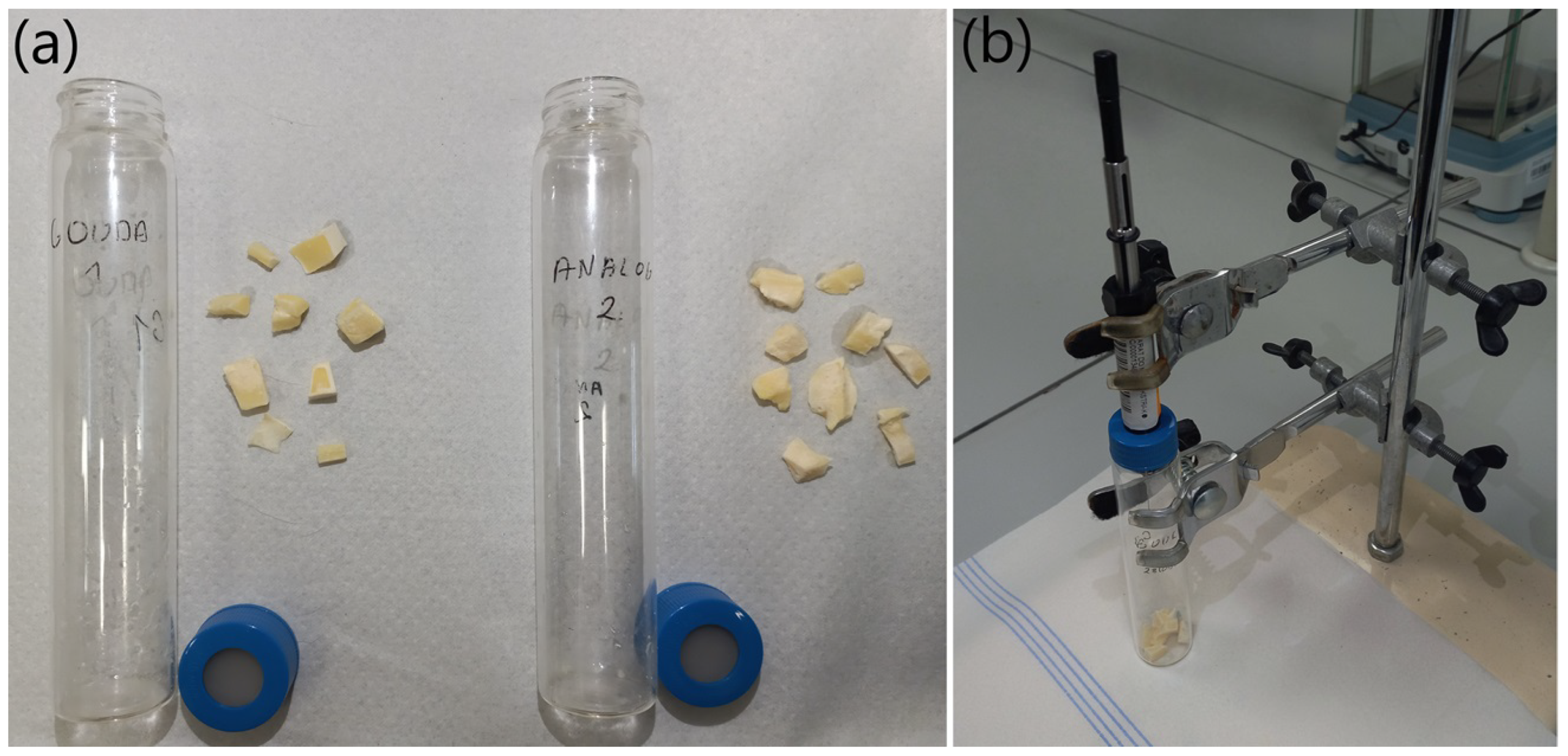

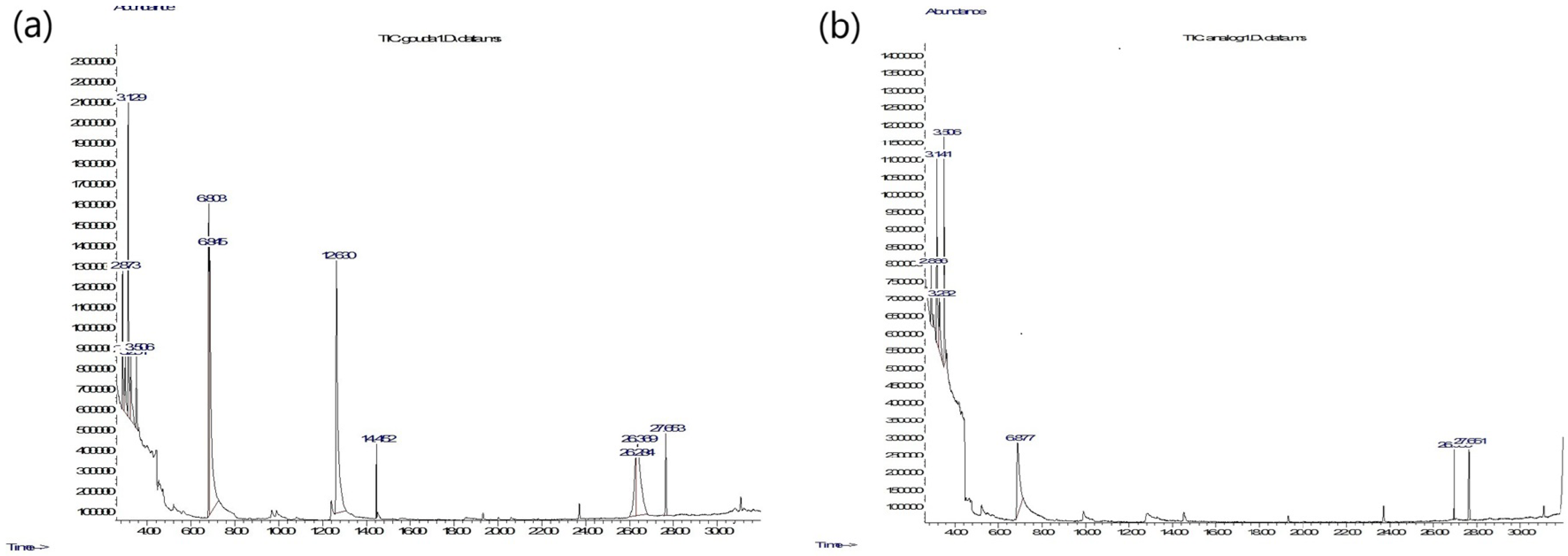
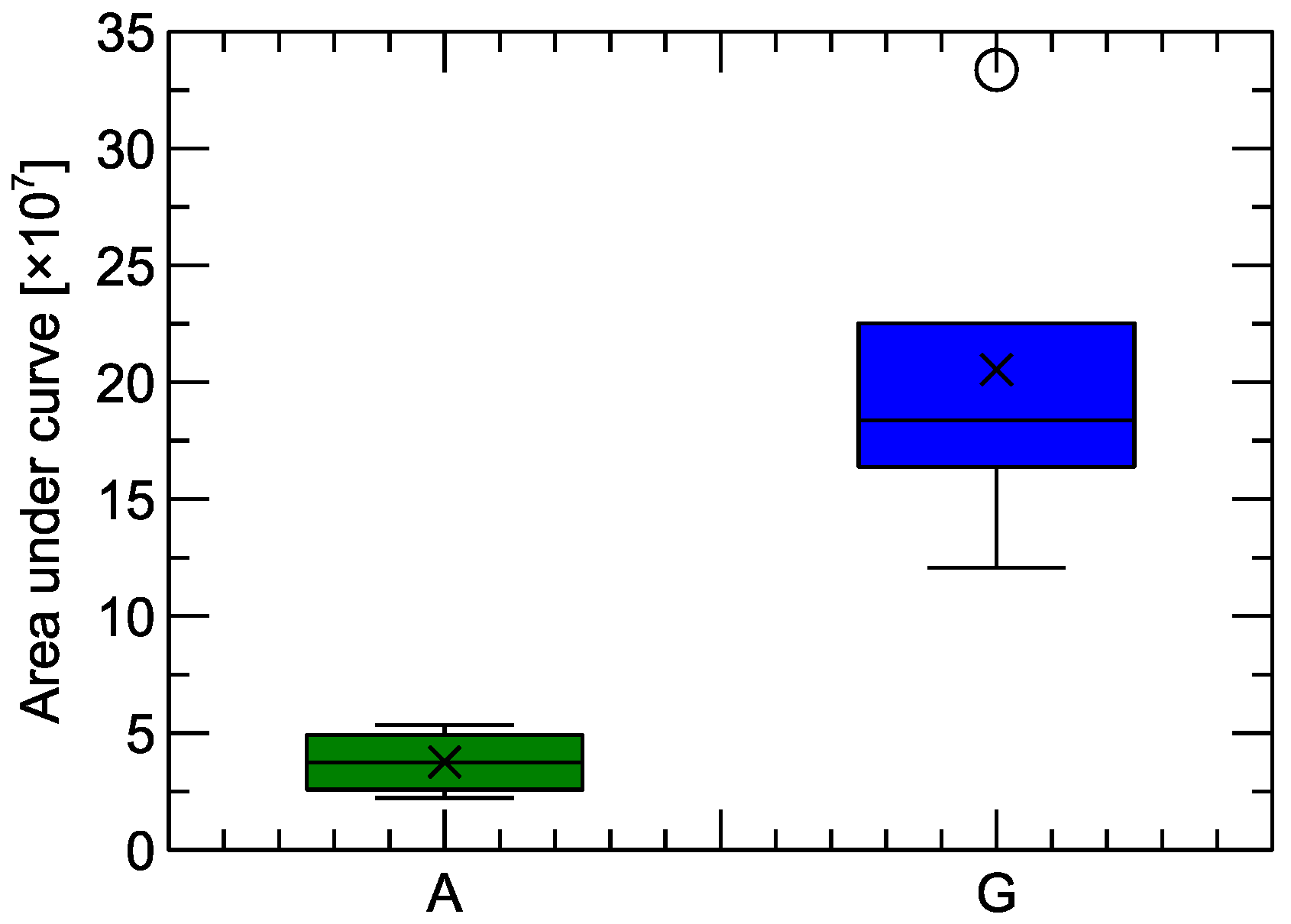
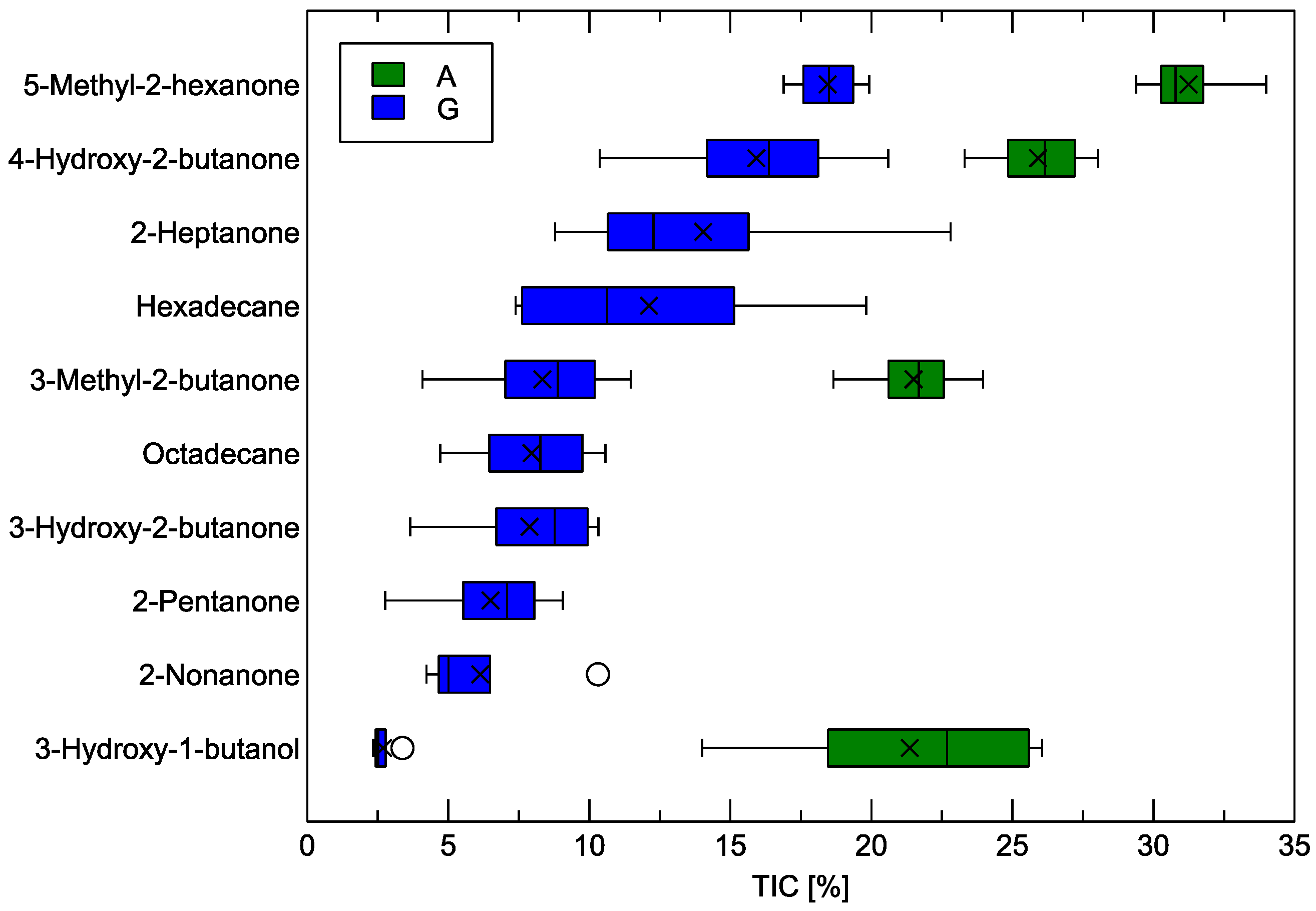
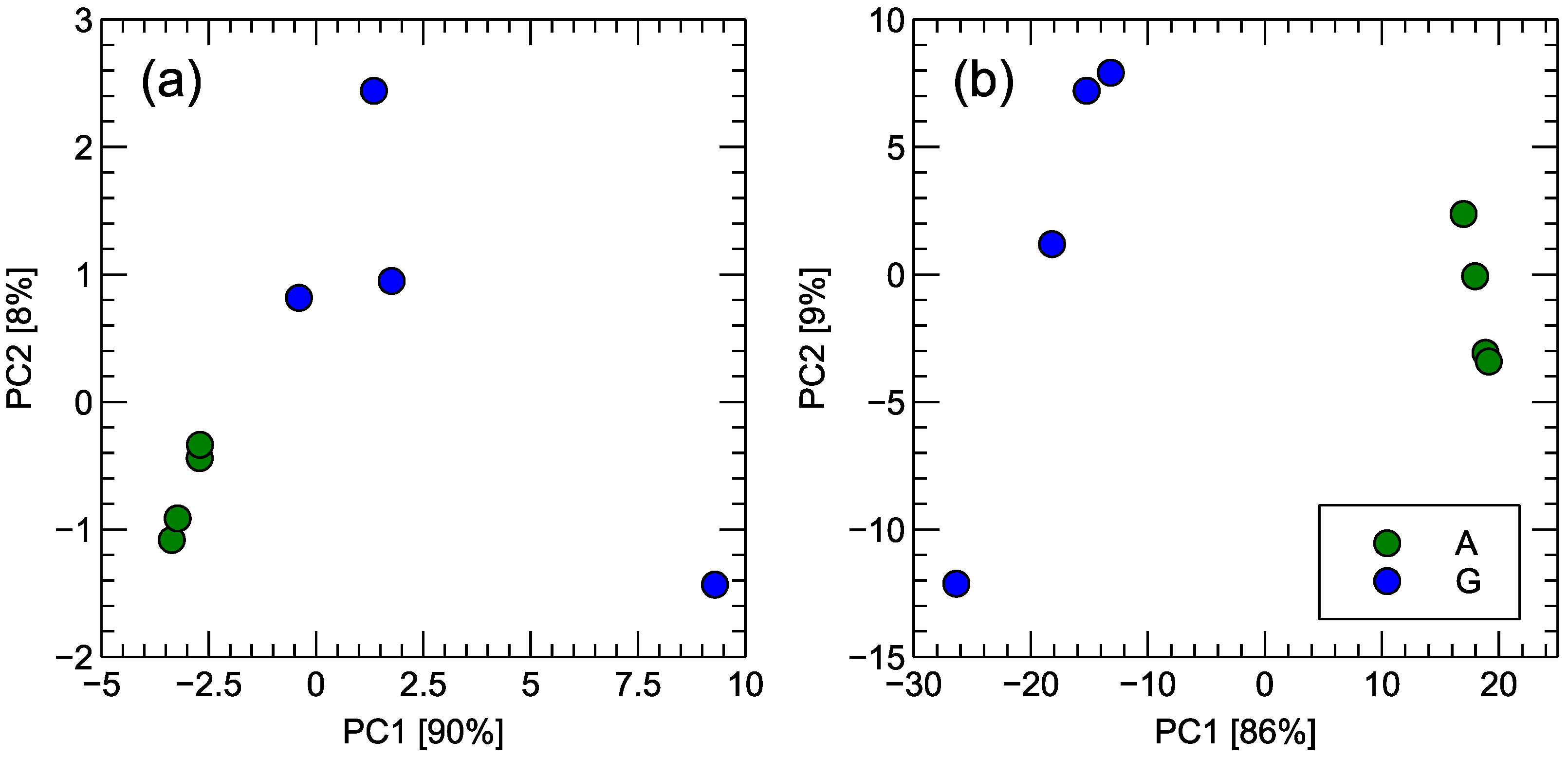
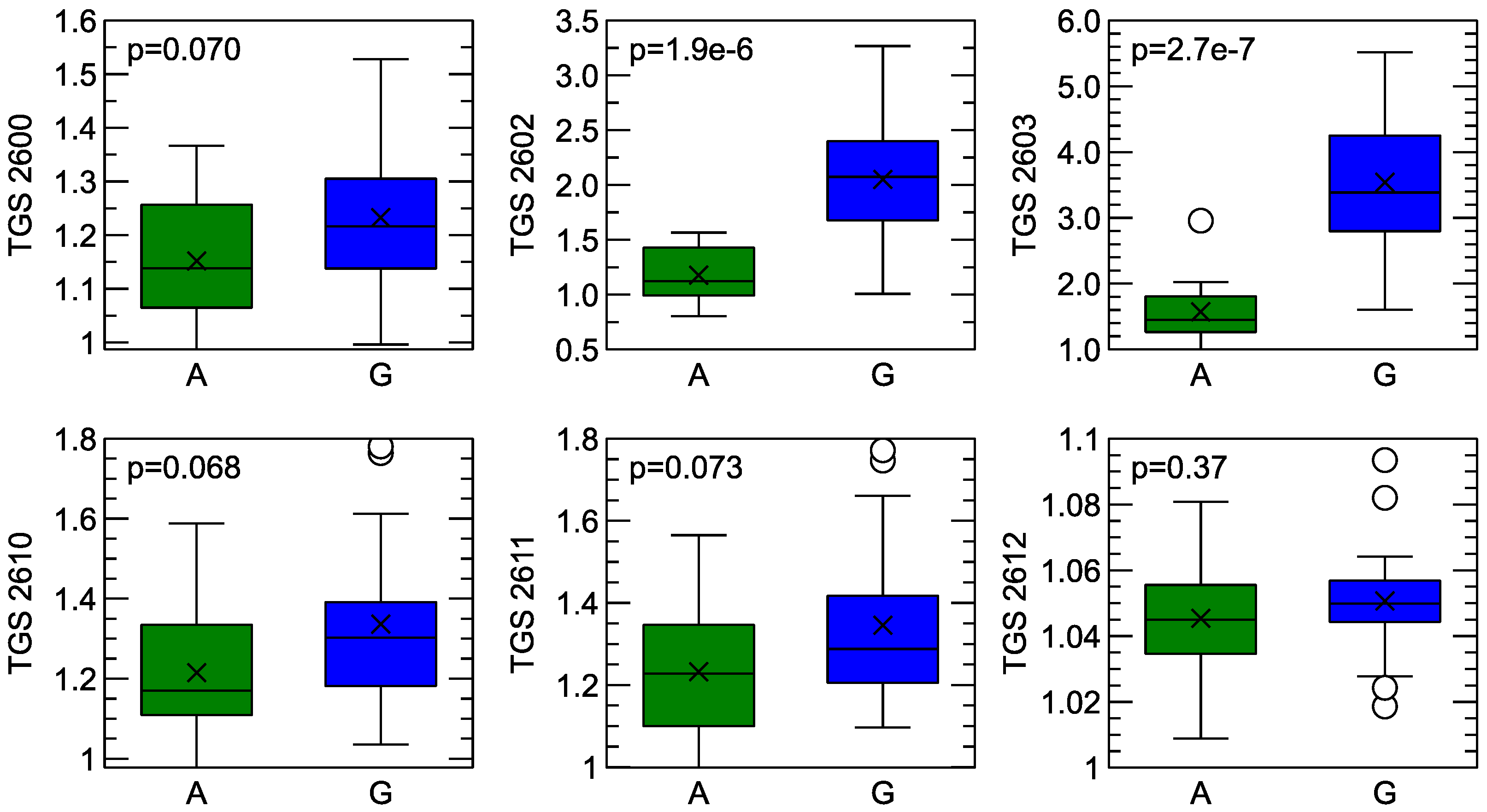

| Compound | Formula | CAS Number | m/z | M+ | tret [min] | RIexp | RIlit | Gouda [%TIC] | Analogue [%TIC] | ||
|---|---|---|---|---|---|---|---|---|---|---|---|
| AVG | STD | AVG | STD | ||||||||
| 3-Methyl-2-butanone | C5H10O | 563-80-4 | 43, 86, 41, 71, 58 | 86 | 2.873 | 664.4 | 666 a | 8.33 | 2.74 | 21.49 | 1.91 |
| 2-Pentanone | C5H10O | 107-87-9 | 43, 86, 41, 71, 58 | 86 | 2.992 | 679.8 | 682 b | 6.50 | 2.34 | ||
| 4-Hydroxy-2-butanone | C4H8O2 | 590-90-9 | 45, 43, 88, 42, 44 | 88 | 3.129 | 697.5 | 698 a | 15.92 | 3.70 | 25.91 | 1.78 |
| 3-Hydroxy-2-butanone | C4H8O2 | 513-86-0 | 45, 43, 32, 88, 44 | 88 | 3.251 | 705.2 | 706 a | 7.88 | 2.63 | ||
| 3-Hydroxy-1-butanol | C5H12O | 123-51-3 | 55, 42, 70, 41, 43 | 88 | 3.506 | 724.0 | 726 c | 2.68 | 0.41 | 21.36 | 4.87 |
| 5-Methyl-2-hexanone | C7H14O | 110-12-3 | 43, 58, 71, 59, 41 | 114 | 6.803 | 855.0 | 857 a | 18.45 | 1.17 | 31.24 | 1.70 |
| 2-Heptanone | C7H14O | 110-43-0 | 43, 58, 71, 59, 41 | 114 | 6.995 | 887.0 | 889 b | 14.04 | 5.31 | ||
| 2-Nonanone | C9H18O | 821-55-6 | 58, 43, 59, 71, 57 | 142 | 12.630 | 1086.0 | 1087 b | 6.14 | 2.43 | ||
| Hexadecane | C16H34 | 544-76-3 | 57, 71, 43, 85, 41 | 226 | 26.284 | 1600.0 | 1600 a | 12.11 | 5.08 | ||
| Octadecane | C18H38 | 593-45-3 | 57, 71, 85, 43, 41 | 254 | 30.962 | 1800.0 | 1800 a | 7.95 | 2.27 | ||
Disclaimer/Publisher’s Note: The statements, opinions and data contained in all publications are solely those of the individual author(s) and contributor(s) and not of MDPI and/or the editor(s). MDPI and/or the editor(s) disclaim responsibility for any injury to people or property resulting from any ideas, methods, instructions or products referred to in the content. |
© 2025 by the authors. Licensee MDPI, Basel, Switzerland. This article is an open access article distributed under the terms and conditions of the Creative Commons Attribution (CC BY) license (https://creativecommons.org/licenses/by/4.0/).
Share and Cite
Borowik, P.; Polak-Śliwińska, M.; Stocki, M.; Hrynyk, H.; Okorski, A.; Pawłowicz, T.; Tarakowski, R.; Orłowski, A.; Oszako, T. Analysis of Volatile Profile of Polish Gouda-Type Cheese and Its Analogue. Agriculture 2025, 15, 336. https://doi.org/10.3390/agriculture15030336
Borowik P, Polak-Śliwińska M, Stocki M, Hrynyk H, Okorski A, Pawłowicz T, Tarakowski R, Orłowski A, Oszako T. Analysis of Volatile Profile of Polish Gouda-Type Cheese and Its Analogue. Agriculture. 2025; 15(3):336. https://doi.org/10.3390/agriculture15030336
Chicago/Turabian StyleBorowik, Piotr, Magdalena Polak-Śliwińska, Marcin Stocki, Heorhiy Hrynyk, Adam Okorski, Tomasz Pawłowicz, Rafał Tarakowski, Andrzej Orłowski, and Tomasz Oszako. 2025. "Analysis of Volatile Profile of Polish Gouda-Type Cheese and Its Analogue" Agriculture 15, no. 3: 336. https://doi.org/10.3390/agriculture15030336
APA StyleBorowik, P., Polak-Śliwińska, M., Stocki, M., Hrynyk, H., Okorski, A., Pawłowicz, T., Tarakowski, R., Orłowski, A., & Oszako, T. (2025). Analysis of Volatile Profile of Polish Gouda-Type Cheese and Its Analogue. Agriculture, 15(3), 336. https://doi.org/10.3390/agriculture15030336








